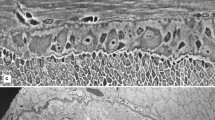Summary
An enveloping sheath of the central nervous system and nerves of chilopods, hitherto called “outer neural lamella” actually consists of mostly myelinized cells supporting the neural lamella. Its fine structure was examinated in some geophilomorphs.
Ganglia, connectives and thick trunk-nerves are enclosed by this myeline sheath totally. The myeline sheath is always formed by several cells; the myelinized parts of them are arranged spirally. The number of their “windings” and therefore also the number of the cells taking part in their construction depend on the region and its diameter: ganglia are distinguished by few “windings” — even missing sporadically —, connectives and nerves are distinguished by numerous ones. In connectives and nerves the number of “windings” is correlated with the thickness of the former. Corresponding to the construction of the myeline sheath by several cells, the pericarya of these cells are located above all within the “windings”. The nuclei are lens-shaped; the cytoplasm contains many spherical mitochondria, cytosomes of various form and density, prevailingly rough endoplasmic reticulum and Golgi fields and free ribosomes near the nucleus. Within the myelinized parts there is no cytoplasm, transparent dilatations between the membranes may be artificial. Cell membranes are outwardly supported by a glycocalyx. Between neighbouring glycocalices there is a haemocoele-cleft of variable width in which haemocytes are not seldom found squeezed in. Adjoining cells of the sheath overlap with their myelinized parts over a large area. Their glycocalyx disappeared and cell contacts have formed, recognizable in sections as septated desmosomes. The meaning of this myeline sheath is discussed.
Zusammenfassung
Eine bisher als „äußere Neurallamelle“ bekannte Hüllschicht des Zentralnervensystems und der Nerven von Chilopoden besteht in Wirklichkeit aus größtenteils myelinisierten Zellen, die der Neurallamelle aufgelagert sind. Ihre Feinstruktur wurde bei einigen Geophilomorpha untersucht.
Ganglien, Konnektiven und Nerven werden als Ganzes von dieser Myelinscheide umschlossen. Sie wird immer von mehreren Zellen, gebildet, deren myelinisierte Abschnitte spiralig angeordnet sind. Die Anzahl der „Wicklungen” und damit auch die der Zellen, die sich an ihrem Aufbau beteiligen, hängt von der Region und von deren Durchmesser ab: Ganglien zeichnen sich durch wenige, Konnektive und Nerven durch viele Wicklungen aus; bei Konnektiven und Nerven steht ihre Zahl im Verhältnis zu deren Dicke. Entsprechend dem Aufbau der Myelinscheide aus mehreren Zellen befinden sich deren Perikaryen vor allem innerhalb der „Wicklungen“. Die Kerne sind linsenförmig; das Zytoplasma enthält viele kugelige Mitochondrien, Zytosomen, überwiegend granuläres endoplasmatisches Retikulum und in Kernnähe Golgi-Komplexe und freie Ribosomen. In den myelinisierten Abschnitten findet man kein Zytoplasma, transparente Erweiterungen werden als Artefakte gedeutet. Den Zellmembranen ist außen eine Glykokalix aufgelagert. Zwischen benachbarten Glykokalizes befindet sich ein unterschiedlich weiter Hämozölspalt, in dem nicht selten Hämozyten eingezwängt liegen. Aneinander anschließende Zellen der Scheide überlappen sich mit ihren myelinisierten Abschnitten über eine größere Fläche. Dort ist die Glykokalix geschwunden und ein Zellkontakt ausgebildet, der im Schnitt häufig septierte Desmosomen erkennen läßt. Die Bedeutung dieser Myelinscheide wird diskutiert.
Similar content being viewed by others
Literatur
Ashhurst, D.E.: The connective-tissue sheath of the locust nervous system: a histochemical study. Quart. J. Microscop. Sci.100, 401–412 (1959)
Ashhurst, D.E.: A histochemical study of the connective-tissue sheath of the nervous system ofPeriplaneta americana. Quart. J. Microscop. Sci.102, 455–461 (1961)
Ashhurst, D.E.: The connective tissue of insects. Ann. Rev. Entomol.13, 45–74 (1968)
Bacetti, B.: Ricerche sulla fine struttura del perilemma nel sistema nervoso degli insetta. Redia40, 197–212 (1955)
Bacetti, B.: Lo stroma di sostegno di organi degli insetti esaminato a luce polarizzatata. Redia41, 259–276 (1956)
Bacetti, B.: Observations by polarized light on the supporting stroma of some organs in insects. Exptl. Cell Res.13, 158–160 (1957)
Bargmann, W.: Histologie und Mikroskopische Anatomie des Menschen, 7. Aufl. Stuttgart: Thieme 1977
Füller, H.: Über Struktur und Chemismus der Neurallamelle bei Chilopoden. Z. Wiss. Zool.169, 203–215 (1964)
Füller, H., Ude, J.: Elektronenmikroskopische Untersuchungen über den Feinbau der Neurallamelle bei Chilopoden. Z. Wiss. Zool.180, 21–33 (1969)
Krstić, R.V.: Ultrastruktur der Säugerzelle. Berlin-Heidelberg-New York: Springer 1976
Leonhardt, H.: Histologie, Zytologie und Mikroanatomie des Menschen, 4. Aufl. Stuttgart: Thieme 1974
Richards, A.G., Schneider, D.: Über den komplexen Bau der Membranen des Binde-gewebes von Insekten. Z. Naturforsch.13b, 680–687 (1958)
Schmitt, F.O.: Molecular Membranology. In: The dynamic structure of cell membranes. (D.F. Hölzl Wallach, H. Fischer, eds.). Berlin-Heidelberg-New York: Springer 1971
Seifen, G.: Entomologisches Praktikum, 2. Aufl. Stuttgart: Thieme 1975
Seifert, G., Rosenberg, J.: Elektronenmikroskopische Untersuchungen der Häutungsdrüsen („Lymphstränge“) vonLithobius forficatus L. (Chilopoda). Z. Morph. Tiere78, 263–279 (1974)
Wigglesworth, V.B.: The haemocytes and connective tissue formation in an insect,Rhodnius prolixus (Hemiptera). Quart. J. Microscop. Sci.97, 89–98 (1956)
Author information
Authors and Affiliations
Rights and permissions
About this article
Cite this article
Rosenberg, J., Seifert, G. Die Myelinscheide um Zentralnervensystem und periphere Nerven der Geophilomorpha (Chilopoda). Zoomorphologie 89, 21–31 (1978). https://doi.org/10.1007/BF00993779
Received:
Issue Date:
DOI: https://doi.org/10.1007/BF00993779




